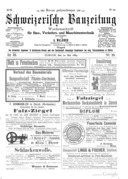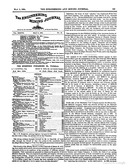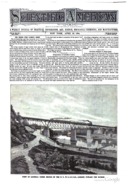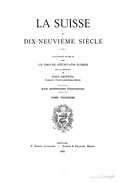[Usually I try to put an image of the machine in this location, but at present I have no freely usable image of a Leschot pantograph. His portrait will have to do.]
[Usually I try to put an image of the machine in this location, but at present I have no freely usable image of a Leschot pantograph. His portrait will have to do.]
Georges-Auguste Leschot (1800-1884), Switzerland (Geneva). A horizontal-format four-bar pantograph engraving / light milling machine for the watchmaking firm of Vacheron & Constantin. This was used for the production of uniform watch plates, and had a significant influence upon the industry. (As late as 2013, the firm ran an advertisement in periodicals for the rich, such as Barron's, illustrating this machine.) At the time of his death he was better-known, even in Switzerland, for his later invention of a diamond drill for the mining industry.
The Leschot pantograph uses the same principle later adopted by Taylor-Hobson (and through them the lighter Gorton machines) of carrying the cutting spindle on a relatively heavy likage guided by a lightweight pantograph mechanism.
(Portrait from {Seippel 1901}.)
Eugène and Alfred Chapuis, in their authoritative The Technique and History of the Swiss Watch from Its Beginnings to the Present Day {Chapuis 1953}, give an account of Leschot and his service to Vacheron-Constantin. (But note that this is from the perspective of semi-official historians of the Swiss watch industry; for a more critical view of the state of interchangeable manufacture in this industry at the time, and Leschot's actual contributions to it, see Landes' analysis as discussed in the section " Swiss and American Watchmaking," below.) Chapuis and Chapuis describe Leschot's work thus:
"Despite all this progress ... manufacturers had not yet arrived at the stage where parts of watches were interchangeable. Several watch-makers and mechanics were seeking the key to this problem.
"It was Georges-Auguste Leschot, son of Jean-Frédéric Leschot, the partner of the Jaquet-Droz, who eventually found methods whereby a considerable degree of interchangeability could be achieved. [This is an admirably diplomatic way of putting it.]
"Georges-Auguste Leschot was born at Geneva in 1800 and died there in 1884. He was apprenticed to watch-making, and afterwards worked at watch jewel making, then finally went into partnership to manufacture and trade in watches. About 1825, he improved the lever escapement by introducing the 'draw', so that this mechanism rapidly entered into current manufacture, and soon assumed very great importance to the industry.
"However, Leschot's own tastes and inventive genius made him turn rather towards the employment of special tools for facilitating and improving watch manufacture.
"G.-A. Leschot had attracted attention to himself by making several tools for manufacturing the lever escapement. At about the same time, the firm of Vacheron & Constantin was trying to standardize its calibres. In 1839, the heads of the firm sought Leschot's invaluable assistance for the purpose of organizing the mechanical manufacture of all the parts of the watch, by means of perfected tools and equipment. He accepted the task, and it was agreed that he should immediately set to work to make the tools and machines, the cost of which was to be borne by Vacheron & Constantin. They agreed to subsidize him up to the point where the equipment 'could be used and would enable gilt movements with lever or cylinder escapements to be manufactured, for which the cases can be made to a standard size for each calibre.'
"Leschot set to work, and succeeded beyond his hopes. He had a pantograph constructed on an extremely solid base, formed from a block of steel 1 metre in length, 52 centimetres wide, and 6 centimetres thick. The template or pattern was six times the size of the actual watch plate to be drilled; it was in brass, with hardened steel bushes in the holes. This apparatus was so arranged that all the holes in a watch plate for the screws and steady pins could be drilled directly. With this application of the pantograph, a brilliant achievement for the period, Vacheron & Constantin long held the field as the only firm which had really resolved a cardinal difficulty in manufacturing, that of accurately locating the holes in a plate. Leschot later invented and constructed a complete series of machine-tools for the manufacture of all parts of the watch; these assured at the same time rapid production, and uniformity in the product.
"Leschot's machines were obviously kept secret, and for a long time Vacheron & Constantin alone benefited from them, but as they made more movements than could they themselves complete, they also sold movements to other watch manufacturers in Geneva.
"Anxious to give public recognition to this work and to the merit of the firm which had encouraged it, the Society of Arts awarded to Messrs. Vacheron & Constantin and Georges Leschot, in 1845, the prize founded by Professor Auguste de la Rive, consisting of a gold medal to the value of 600 francs." (pp. 176-177)
As Leschot was awarded a prize for this machine in 1845, the "long" period of time during which they were kept secret could not have exceeded six years.
All of the photographs that I have been able to discover of Leschot's pantograph are of what appears to be the same machine (or perhaps two very similar machines) preserved at Vacheron-Constantin.
I know of no freely reproduceable images of Leschot's pantograph.
A photograph of a Leschot pantograph, purportedly dated to 1857, appears on the " Fondation De La Haute Horlogerie" website at http://www.hautehorlogerie.org/en/encyclopaedia/glossary/s/pantograph/ and also in a forum entry at: http://www.thehourlounge.com/thread/view/calibre-leschot_67363_67363.html
What appears to be a multiple-exposure photograph of a part of the motion of this machine appears on the " Fondation De La Haute Horlogerie" website at http://www.hautehorlogerie.org/en/history/facts/XIX/1839/
A photograph of the Leschot pantograph preserved in the Vacheron-Constantin factory appears in an account of a field trip there at: http://people.timezone.com/library/extras/200511205006
A photograph of a Leschot pantograph, appears in a forum posting at: http://revo-online.com/forums/main/read.php?2,1008004,1008025 which in turn links to a "photobucket" image at: http://s116.photobucket.com/user/JackForster/media/Vacheron%20Visit%20Spring%202012/P1020687.jpg.html This photograph was taken by JackForster at Vacheron-Constantin in 2012.
A photograph of a Leschot pantograph appears on a Polish website at http://chronos24.pl/z-wizyta-w-maison-i-manufakturze-vacheron-constantin/
A tiny image of a Leschot pantograph appears at http://www.rawbw.com/~hbv/horology/pantograph.html This is a version of the full-page plate (plate 117) which appeared in {Chapuis 1953}.
See also the " Bibliography," below.
There are several references to Leschot in the online and print literature of high-end watchmaking, but everything from the late 20th century on is more or less hagiographic and of little use. Here are some earlier sources. Sadly, they are for the most part obituaries.

Schweizerische Bauzeitung (1884)
Colladon, Daniel. "Georges Leschot, et l'invention des perforatrices à diamant." [obituary] Schweizerische Bauzeitung. Vol. 3, No. 19 (1884-05-10). Zurich.
This is a relatively detailed obituary.
This book has been digitized (poorly) by Google. The icon at left links to an extract of just the page with this obituary.

Engineering and Mining Journal. (1884)
Anon. [obituary] The Engineering and Mining Journal. Vol. 37, No. 18 (1884-05-03): 333.
This book has been digitized (poorly) by Google. The icon at left links to an extract of just the page with this obituary.

Jewelers' Circular (1884)
Anon. [obituary] The Jewelers' Circular and Horological Review. Vol. 15, No. 3 (April 1884): 91.
This book has been digitized by Google from the New York Public Library copy. The icon at left links to an extract of just the page with this obituary.

Leschot & Thury. [Friction] (1866)
Leschot, Georges-Auguste and Marc Thury. "Notice sur un nouveau moyen de supprimer le frottement." ["Instructions on a new way to remove friction."] (1866)
I know of this only through a Google Books snippet; it is not available for viewing, and I have not seen it.

Scientific American (1884)
Anon. "Georges Leschot, Inventor of the Diamond Drill." [obituary] Scientific American. Vol. 50 (New Series), No. 17 (April 26, 1884): 257.
This book has been digitized by Google from the Stanford University copy. The icon at left links to an extract of just the page with this obituary.

Seippel (1901)
Seippel, Paul, ed. [Extract from] La Suisse au dix-neuvième siècle. Lausanne, CH: F. Payout, 1901.
This book has been digitized by Google from the University of Michigan copy. The icon at left links to an extract of pp. 132-135, which contain information on and a portrait of Leschot.

Thury. Journal Suisse d'horlogerie (1884)
Thury. "Georges Leschot" [obituary] Journal Suisse d'horlogerie. 8th Year, No. 9 (March 1884): 250-254.
This volume of this journal has been digitized by Google from the NYPL copy. The icon at left links to an extract of Thury's obituary of Leschot.
The Swiss watch of today is a masterpiece of the marketer's art. It is a mass-produced item (albeit a very well made one) which has attached to it a mystique like that of no other industrial product. It is sold as the culmination of hundreds of years of precision watchmaking. Of course, this is not true.
The Swiss watch industry prior to the middle of the 19th century did have a reputation for mass-produced watches, but it was largely a reputation for inexpensive watches, often poorly made. This was achieved through a system of coordinated but distributed manufacture of components (often in mountain households during the winters) which were then assembled and hand-finished.
Leschot's pantograph has been cited with considerable authority as "one of the foundations of interchangeability in watch movements at that period" {Chapuis 1953} However, this wasn't really the case. David Landes, in his classic study of the history and economics of the international watchmaking industry, Revolution in Time, points out that "The pieces produced by his pantographic drills and cutters were alike to fairly small tolerances, but they had to be made in soft steel and still required tempering, which altered their shape and yielded 25 percent or more of rejects." (p. 293)
The increased mechanization of the Swiss industry from the 1840s (Leschot) through the 1870s served to speed up the finishing of watches, but was not a technology for the mass production of watches with interchangeable parts.
Rather, the development of modern watch manufacturing with interchangeable (or very nearly interchangeable) parts happened in the United States in the middle of the 19th century. It was ignored by the Swiss until the 1870s, when exports of Swiss watches to America fell abruptly from 18 million francs (in 1872) to under 5 million francs (just four years later, in 1876). In that year, the Swiss industry sent a representative, Edouard Favre-Perret, to the Centennial Exhibition in Philadelphia and to study the American industry. ( {Landes 1983}, p. 319) He delivered a report which transformed the Swiss watch industry. It adopted the technology of the "American System" into an much more rigorous management structure.
The real evidence of the adoption of the "American System" of manufacturing by the Swiss watch industry is not Landes' claim, but Favre-Perret's evidence. Here are the last two paragraphs of his conculsions, as presented by him in a speech to the Swiss watch industry in 1876. Note that in these remarks he establishes first that the American watch, unlike the Swiss, was made of parts completely interchangeable down to the hairspring and second that the watch so produced was of higher quality than any but the few finest watches of Swiss manufacture. This was 37 years after the introduction of Leschot's pantograph.
(From {Watson 1877}
In the 1920s and 1930s, the American watch industry committed suicide through spectacularly bad management ( {Landes 1983}, pp. 328-335) of a style that has become recognized since 2007 as a very different "American System." The Swiss industry survived, and rewrote its history as one of a homegrown tradition of precision manufacture.
The public relations departments of the Swiss watchmaking industry might have met their match with the PR department of the American Type Founders Company. ATF would have had us believe that modern typecasting matrix manufacturing began with Linn Boyd Benton's invention of the pantograph in 1885. So successful was ATF in promoting this view that it persists today - you'll find it repeated in brand new 21st century books on the history of type.
Yet the first matrices for typecasting in America were cut in 1882 by pantograph at the Central Type Foundry . This was two years before Benton made the first public announcement of his pantograph (for cutting patrices in typemetal and punches in steel, at that time). Benton didn't actually cut matrices directly until 1899. By the late 1880s, typographical matrix engraving was available as a third-party commercial service ( Schroeder & Werner, first in partnership and then independently; they cut, among other faces, DeVinne). In the early 1890s, Robert Wiebking began his pantographic matrix and punch engraving services (cutting, for example, Goudy's early types). Wiebking also later provided the pantographic machinery which enabled the punch and matrix production of the Ludlow Typograph Company. None of these pantographs had any relationship at all to Benton's.
Yet they may have had a link back to Leschot. The Central Type Foundry pantograph, first employed successfully in 1882, had been imported from Germany by the Cincinnati Type Foundry in 1880. We know nothing about this machine save that it was a horizontal-format pantograph. Wiebking's pantographs, which produced a disproportionate amount of the metal type of the 20th century, were developed by Wiebking and Henry H. Hardinge from an early pantograph that Wiebking's father brought with him when he emigrated from German in 1880.
Clearly, there were important pantograph engraving machines being made in Germany in the 1870s. Unfortunately, in the US we know almost nothing about them. So far, the most interesting case I've seen is that of Ferdinand Lotz, of Offenbach am Main. His machines were exported worldwide, and were exhibited at the same 1876 Centennial Exhibition attended by Favre-Perret. This was a major event - the first world fair in the US. It is probably safe to assume that every typefounder in America (except perhaps Benton, isolated in Milwaukee) saw them there.
The evidence of Lotz' machines suggests two things: First, that the range of pantograph machinery in Germany in the 1870s was wide. There wasn't just one machine or style of machine. Second, that in at least one case there are significant similarities between one of these machines and Leschot's pantograph of the late 1830s.
This argument for a path from Leschot's pantograph in the late 1830s through Germany to the true beginnings of typographical matrix engraving by machine in American in 1882 is, at present, just a hunch. I don't yet have enough evidence to link up these few data points. But it merits further research.
Leschot did much more than build a single pantograph. His role at Vacheron-Constantin was to develop a complete manufacturing system. He seems to have been involved with a number of other things as well. In mining circles, he was noted in his obituaries not as a watchmaker but as the inventor of a heavy industrial diamond drill.
See also " Literature," above.
{Chapuis 1953 } Chapuis, Eugène and Alfred Chapuis, with G. Albert Bermer. Trans. D. S. Torrens and C. Jenkins. The Technique and History of the Swiss Watch from Its Beginnings to the Present Day . Olten, CH: Urs Graf-Verlag, 1953.
The Chapuis' book is both useful and authoritative, but it must be used with caution as it was in spirit a public-relations document from the Swiss industry. It does not even mention Edouard Favre-Perret or his report which introduced the American System of manufacture into Swiss watchmaking (instead, it argues that certain aspects of Swiss manufacturing practice were "incorrectly called the American Method" (p. 179)).
{Favre-Perret 1876} The 1877 report by Edouard Favre-Perret which reshaped the Swiss watch industry is difficult to find. It contradicts the creation myth at the heart of the present success of Swiss watch marketing, so it has been conveniently forgotten by that industry. {Landes 1983} gives the basic bibliography (in notes 26 - 29 to his Chapter 19, on pp. 461-462. The sources are:
The "official" presentation, cited by Landes, seems to be: Favre-Perret, Edouard. Rapport présenté au Haut Conseil Fédéral sur l'industrie de l'horlogerie: Exposition de Philadelphie, 1876, Section Suisse, Groupe XXV. (Winterthur, 1877)
Another "official" presentation, cited by Landes, in La Nationale suisse. [Vol. and No. unknown to me] (Nov. 17, 1876): [pages unknown to me] (La Chaux-de-Fonts, CH: [publisher?], 1876).
Moore. Timing a Century [an incomplete translation; this volume is a history of the Waltham company]
Fried, Henry. "Time is Money." [unpublished manuscript. This contains a complete translation. It is the source Landes used.]
Favre-Perret also delivered this paper as a speech. A translation into English of extracts from that speech as it was presented at La Chaux-de-Fonds on 1876-11-14 is reprinted in {Watson 1877}. This speech and this source are not noted by Landes.
{Landes 1983} Landes, David. Revolution in Time: Clocks and the Making of the Modern World. Cambridge, MA: The Belknap Press of Harvard University Press, 1983.
{Watson 1877} Waston, James C. American Watches: An Extract from the Report on Horology at the International Exhibition at Philadelphia, 1876 . NY: Robbins & Appleton, 1877.
To the extract from the "Report on Horlogy" this volume adds, as an appendix, a translation of "Extracts from a speech delivered at Chaux-de-Fonds, Switzerland, by M. Edouard Favre-Perret..."
This has been scanned by Google from the Univ. of Michigan copy (though they list it, confusingly, under the title "Pamphlets and Reprints". Here is a local copy of the Google PDF: watson-1877-american-watches-google-mich-incl-favre-perret-report-extract.pdf
All portions of this document not noted otherwise are Copyright © 2012, 2022 by David M. MacMillan.
Circuitous Root is a Registered Trademark of David M. MacMillan.
This work is licensed under the Creative Commons "Attribution - ShareAlike" license, version 4.0 International. See http://creativecommons.org/licenses/by-sa/4.0/ for its terms.
Presented originally by Circuitous Root®